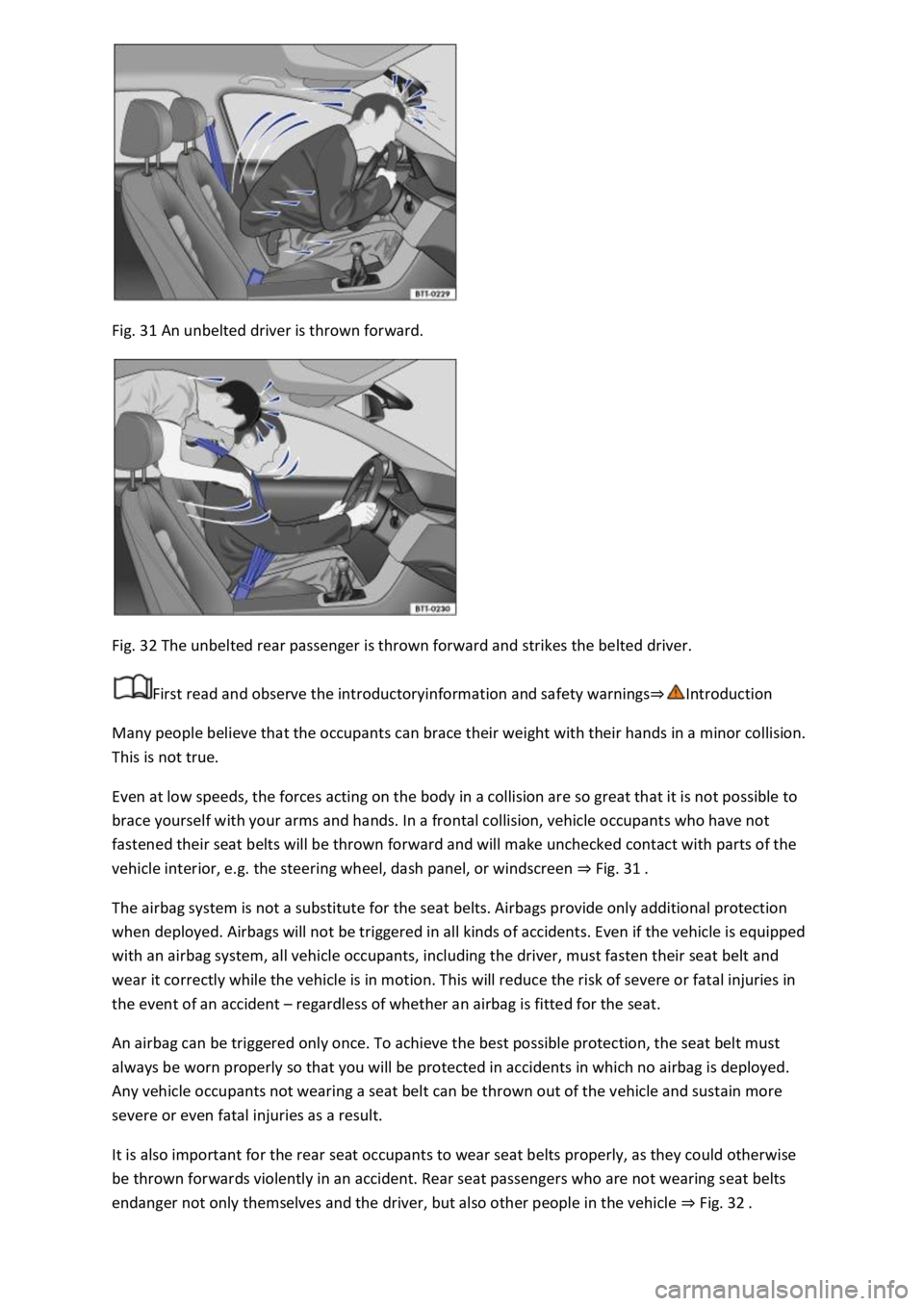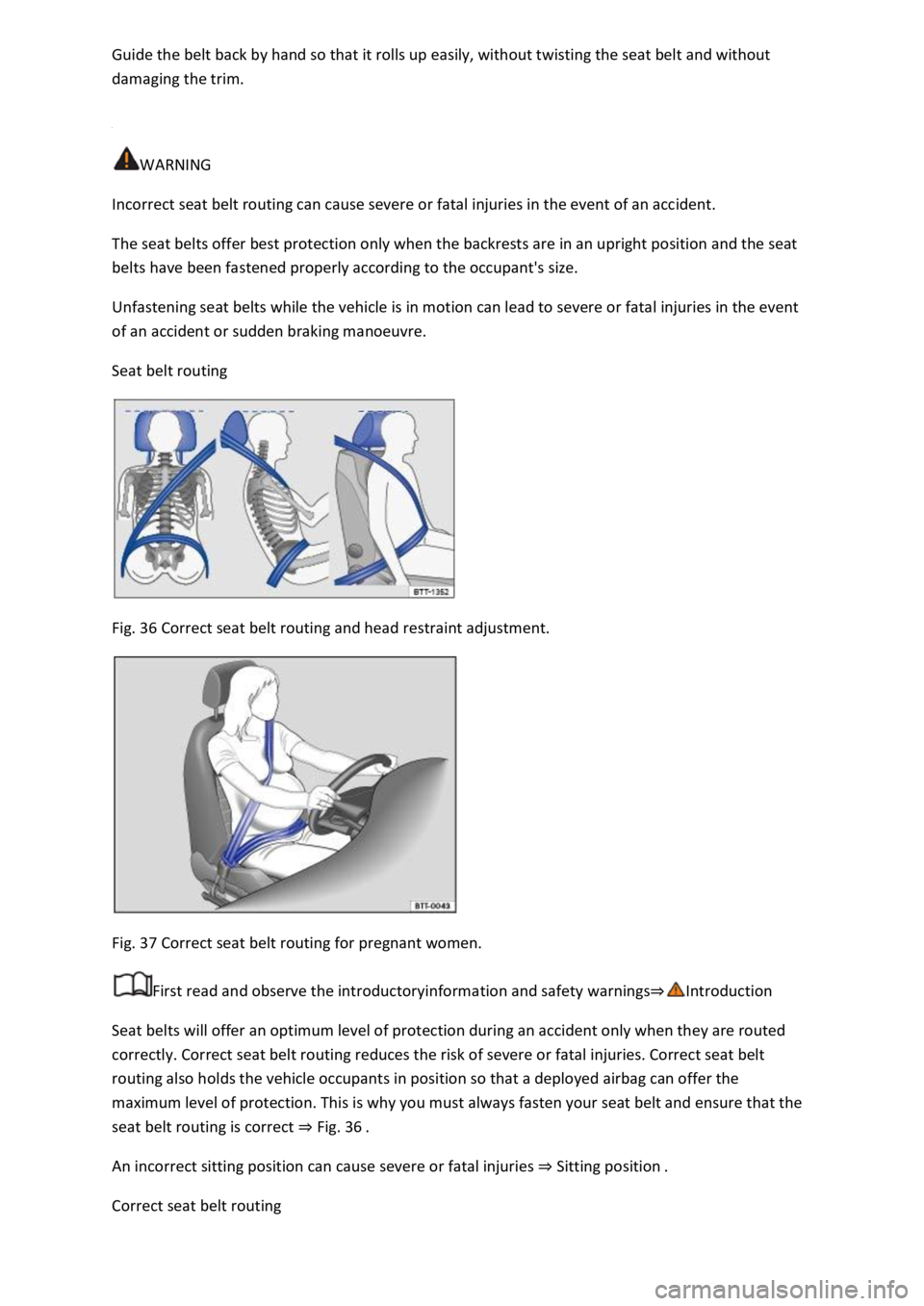2020 VOLKSWAGEN T-ROC warning
[x] Cancel search: warningPage 55 of 502

seat belt belonging to their seat and keep it fastened properly throughout the trip. This applies to all
vehicle occupants and also in urban traffic.
While the vehicle is in motion, secure all children travelling in the vehicle in a restraint system
suitable for their weight and height. They must also wear correctly fastened seat belts Safe
transport of children
Drive off only when all passengers have correctly fastened their seat belts.
Never insert the latch plate into a buckle which does not belong to the corresponding seat and
always ensure it engages properly. Using a buckle which does not belong to the seat you are
occupying reduces the level of protection and can lead to severe injuries.
Never let any foreign bodies or liquids get into the slots for the belt buckles. This could prevent the
belt buckle and seat belt from working properly.
Never unfasten the seat belt while the vehicle is in motion.
Never allow more than one person to share the same seat belt.
Never travel when children or babies are being carried on somebody's lap and fastened with the
same belt.
Never travel wearing loose, bulky clothing (such as an overcoat over a jacket). This could prevent the
seat belts from fitting and functioning properly.
WARNING
Damaged seat belts are very dangerous and could cause severe or fatal injuries.
Never damage the belt by trapping it in the door or in the seat mechanism.
If the belt webbing or any other part of the seat belt becomes damaged, the seat belts may tear
during an accident or sudden braking manoeuvre.
Have damaged seat belts immediately replaced by new seat belts that have been approved by
Volkswagen for the vehicle. Seat belts subjected to stress and stretched during an accident must be
replaced by a qualified workshop. Renewal may be necessary even if there is no apparent damage.
The belt anchorage should also be checked.
Never try to repair, modify or remove the seat belts yourself. All repairs to the seat belts, belt
retractors and buckles must be carried out by a qualified workshop.
Warning lamp
Page 56 of 502

Fig. 27 On the instrument cluster display: warning lamp.
Fig. 28 On the instrument cluster display: seat belt status for the rear seats.
First read and observe the introductoryinformation and safety warnings
A signal tone will sound for a few seconds if the seat belts are not fastened as the vehicle pulls off
and reaches a speed of more than approximately 25 km/h (15 mph), or if the seat belts are
unfastened while the vehicle is in motion. This is accompanied by the flashing warning lamp
Fig. 27
The warning lamp does not go out until the driver and front passenger fasten their seat belts
while the ignition is switched on.
Belt status display for the rear seats
After the ignition has been switched on, the belt status display Fig. 28on the instrument cluster
display shows the driver whether the rear seat passengers have fastened their seat belts. The
symbol indicates that the passenger on this seat has fastened their seat belt. The symbol
indicates that the seat belt has not been fastened.
The belt status display will be shown for approximately 30 seconds if a seat belt is fastened or
unfastened on the rear seats. The display is hidden automatically after 30 seconds.
If a seat belt for one of the rear seats is unfastened while the vehicle is in motion, the belt status
display will flash for a maximum of 30 seconds. If the vehicle is travelling faster than approximately
25 km/h (15 mph), a signal tone will also be given.
WARNING
Incorrectly fastened or unfastened seat belts increase the risk of severe or fatal injuries. Seat belts
will only offer the optimum level of protection when they are fastened and used properly.
Frontal collisions and the laws of physics
Page 57 of 502

Fig. 29 Unbelted occupants in a vehicle heading towards a brick wall.
Fig. 30 Unbelted occupants in a vehicle striking a brick wall.
First read and observe the introductoryinformation and safety warnings
The physical principles involved in a frontal collision are relatively simple. As soon as the vehicle is in
motion Fig. 29
The higher the vehicle speed and the heavier the weight of the vehicle, the greater the amount of
energy that will have to be released in the event of an accident.
The most significant factor, however, is the speed of the vehicle. For example, if the speed doubles
from 25 km/h to 50 km/h (15 mph to 31 mph), the kinetic energy increases by a factor of four.
The amount of kinetic energy depends on the speed of the vehicle and the weight of the vehicle and
passengers. The higher the speed and the greater the weight, the more energy there is to be
released in an accident.
Passengers who are not wearing seat belts are not attached to the vehicle. In the event of a frontal
collision, they will continue to move forwards at the same speed at which the vehicle was travelling
before impact, until something stops them. Because the vehicle occupants in our example are not
restrained by seat belts, their entire kinetic energy will be released only at the point of impact
against the wall Fig. 30
Even at speeds of approximately 30 km/h (19 mph) to approximately 50 km/h (31 mph), the forces
acting on bodies in a collision can easily exceed one tonne (1,000 kg). These forces are even greater
at higher speeds.
This example applies not only to frontal collisions, but to all accidents and collisions.
What happens to vehicle occupants who have not fastened their seat belts
Page 58 of 502

Fig. 31 An unbelted driver is thrown forward.
Fig. 32 The unbelted rear passenger is thrown forward and strikes the belted driver.
First read and observe the introductoryinformation and safety warnings
Many people believe that the occupants can brace their weight with their hands in a minor collision.
This is not true.
Even at low speeds, the forces acting on the body in a collision are so great that it is not possible to
brace yourself with your arms and hands. In a frontal collision, vehicle occupants who have not
fastened their seat belts will be thrown forward and will make unchecked contact with parts of the
vehicle interior, e.g. the steering wheel, dash panel, or windscreen Fig. 31
The airbag system is not a substitute for the seat belts. Airbags provide only additional protection
when deployed. Airbags will not be triggered in all kinds of accidents. Even if the vehicle is equipped
with an airbag system, all vehicle occupants, including the driver, must fasten their seat belt and
wear it correctly while the vehicle is in motion. This will reduce the risk of severe or fatal injuries in
the event of an accident regardless of whether an airbag is fitted for the seat.
An airbag can be triggered only once. To achieve the best possible protection, the seat belt must
always be worn properly so that you will be protected in accidents in which no airbag is deployed.
Any vehicle occupants not wearing a seat belt can be thrown out of the vehicle and sustain more
severe or even fatal injuries as a result.
It is also important for the rear seat occupants to wear seat belts properly, as they could otherwise
be thrown forwards violently in an accident. Rear seat passengers who are not wearing seat belts
endanger not only themselves and the driver, but also other people in the vehicle Fig. 32
Page 59 of 502

Fig. 33 Driver restrained by a properly worn seat belt during a sudden braking manoeuvre.
First read and observe the introductoryinformation and safety warnings
Properly worn seat belts can make a major difference. When worn correctly, seat belts hold the
vehicle occupants in the correct sitting positions and considerably reduce the kinetic energy in the
event of an accident. Seat belts also help to prevent uncontrolled movements that could lead to
severe injuries. In addition, wearing seat belts properly reduces the risk of being thrown from the
vehicle Fig. 33
Passengers wearing seat belts correctly benefit greatly from the ability of the belts to reduce the
kinetic energy. The front crumple zones and other passive safety features (such as the airbag
system) are also designed to reduce kinetic energy. The amount of energy generated will thus
decrease, thereby reducing the risk of injury.
The examples describe frontal collisions. Of course, properly worn seat belts also substantially
reduce the risk of injury in all other types of accidents. This is why seat belts must be fastened
before every trip even if you are just driving round the corner. Ensure that all passengers also wear
their seat belts properly.
Accident statistics have shown properly worn seat belts to be an effective means of substantially
reducing the risk of injury and improving the chances of survival in a serious accident. Furthermore,
properly worn seat belts improve the protection provided by airbags in the event of an accident. For
this reason, wearing a seat belt is required by law in most countries.
Although the vehicle is equipped with airbags, the seat belts must be fastened and worn. For
example, the front airbags will be triggered only in certain types of frontal collision. The front airbags
will not be triggered as a result of minor frontal collisions, minor side collisions, rear collisions,
rollover or accidents in which the airbag trigger threshold in the control unit is not exceeded.
Therefore, always wear your seat belt and ensure that your passengers have fastened their seat
belts properly before you drive off!
Using seat belts
First read and observe the introductoryinformation and safety warnings
Checklist
Page 60 of 502

Regularly check the condition of all seat belts.
Keep the seat belts clean.
Avoid allowing any foreign bodies or fluids to get on to the seat belt or latch plate or into the slot for
the seat belt buckle.
Do not trap or damage the seat belt and latch plate, for example when closing the door.
Never remove, modify or repair the seat belt or belt anchorage elements.
Always fasten the seat belt correctly before any journey and wear it properly while the vehicle is in
motion.
Twisted seat belt
If it is difficult to pull the seat belt out of the belt guide, the seat belt may have become twisted in
the side trim as a result of being retracted too quickly when unfastened:
Take hold of the latch plate, then slowly and carefully pull out the seat belt fully.
Untwist the seat belt and guide it back slowly by hand.
Fasten the seat belt even if you are unable to undo the twist. However, the twist should not be in
part of the seat belt which comes into direct contact with the body. The twist should be corrected
immediately by a qualified workshop.
WARNING
Using seat belts incorrectly increases the risk of severe or fatal injuries.
Regularly check to ensure that the seat belt and its related parts are in perfect condition.
Always keep the seat belt clean.
Do not allow the belt webbing to become jammed, damaged or to rub on any sharp edges.
Always keep the latch plate and slot in the buckle free from foreign bodies and liquids.
Fastening and unfastening seat belts
Page 61 of 502

Fig. 34 Inserting the seat belt latch plate into the buckle.
Fig. 35 Removing the latch plate from the buckle.
First read and observe the introductoryinformation and safety warnings
If worn properly, seat belts hold the vehicle occupants in the correct sitting position during an
accident or braking manoeuvre, providing maximum protection
In vehicles with a proactive occupant protection system, the driver and front passenger seat belts
are automatically tensioned in certain situations Proactive occupant protection system
In addition, belt slack can be minimised.
Fastening seat belts
Fasten seat belts before every trip.
Adjust the front seat and head restraint correctly Sitting position
Engage the rear seat backrest in an upright position
Take hold of the belt and pull it evenly across your chest and pelvis. Do not twist the belt in the
process
Insert the latch plate securely into the buckle belonging to the occupied seat Fig. 34
Pull on the seat belt to ensure that the latch plate is securely locked in the buckle.
Unfastening seat belts
Unfasten seat belts only when the vehicle is stationary
Press the red button in the buckle Fig. 35 latch plate is released and springs out.
Page 62 of 502

damaging the trim.
WARNING
Incorrect seat belt routing can cause severe or fatal injuries in the event of an accident.
The seat belts offer best protection only when the backrests are in an upright position and the seat
belts have been fastened properly according to the occupant's size.
Unfastening seat belts while the vehicle is in motion can lead to severe or fatal injuries in the event
of an accident or sudden braking manoeuvre.
Seat belt routing
Fig. 36 Correct seat belt routing and head restraint adjustment.
Fig. 37 Correct seat belt routing for pregnant women.
First read and observe the introductoryinformation and safety warnings
Seat belts will offer an optimum level of protection during an accident only when they are routed
correctly. Correct seat belt routing reduces the risk of severe or fatal injuries. Correct seat belt
routing also holds the vehicle occupants in position so that a deployed airbag can offer the
maximum level of protection. This is why you must always fasten your seat belt and ensure that the
seat belt routing is correct Fig. 36
An incorrect sitting position can cause severe or fatal injuries
Correct seat belt routing